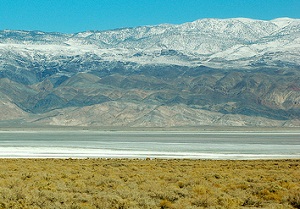Mud halts solar project
 Last week, the Los Angeles Department of Water and Power (DWP) drastically reduced its ambitious plan to put photovoltaics (PVs) on roughly 80 square miles of Owens Lake’s dry bed—not because of money, but because of you guessed it, caustic mud. So a project that would have covered 80 acres is now being scaled back to a five-acre pilot project on the lake bed’s northern end, according to The L.A. Times. As it was introduced, earlier this year, the project would have generated about 10 percent of all California’s energy needs using solar.
Last week, the Los Angeles Department of Water and Power (DWP) drastically reduced its ambitious plan to put photovoltaics (PVs) on roughly 80 square miles of Owens Lake’s dry bed—not because of money, but because of you guessed it, caustic mud. So a project that would have covered 80 acres is now being scaled back to a five-acre pilot project on the lake bed’s northern end, according to The L.A. Times. As it was introduced, earlier this year, the project would have generated about 10 percent of all California’s energy needs using solar.
The project is being scaled back so drastically—at least for now— because of very corrosive soil. Engineers determined that PV panels installed in the lake bed would sink several inches into the soil, which would eat away at the panels and their mounting systems. DWP expects to unveil its new plans for Owens Lake in August.
Still, the north end of the lake is being looked at to provide about 2 square miles of solar power, DWP engineer Bill Van Wagoner told the Times. "It's going to be more challenging than we thought to do it on the lake bed," he said.
The project was originally conceived of as a way to help control dust blown from the nearly 110-square mile, dry lake bed. Owens Lake is a prehistoric lake in the shadow of the Sierra Nevada mountain range, which is pounded by gale-force winds that whip up hazardous dust storms. The solar panels were seen as a way to mitigate dust without using a lot of water from Owens River.
Environmentalists had approved of the PV plan because it didn’t pull water from other sources and because of the clean energy it would have produced.
It is possible to build PV arrays that can withstand the loose, corrosive soil in the lake bed and the intense winds that blow through Owens Valley. But it would add significant cost to the project.
"The real question is this: Can Los Angeles afford it?" Ted Schade, head of the regional air quality district told The L.A. Times.



